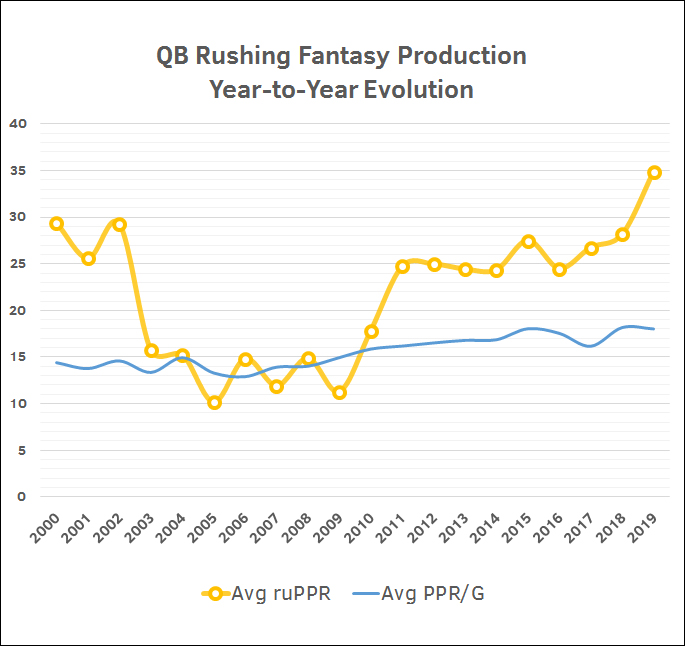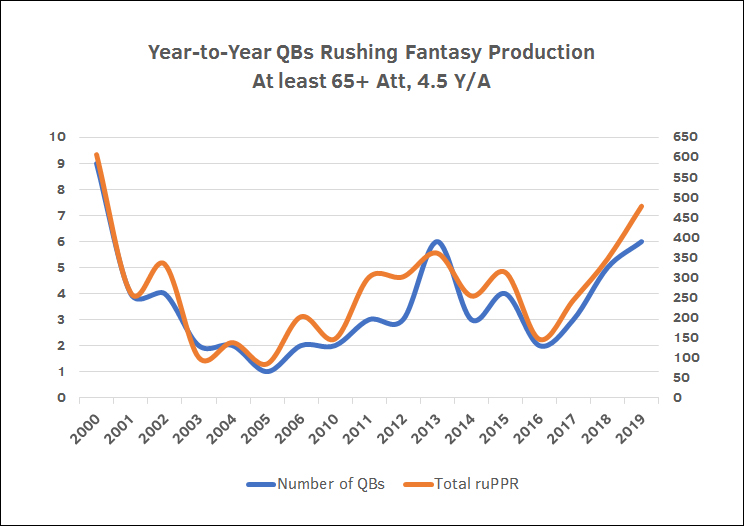The 2019 fantasy season is over. We are all thinking about what to do come 2020 draft day. So let me ask you something. What if I offer you the chance of drafting a quarterback who is a lock to finish the season with 270 fantasy points? Would you take him and make him your QB1 all year long? Those are not bad numbers, truth be told. A total of 270 points in a 16-game season yield an average of almost 17 FP/G. Are those points good enough for a QB1? Since I have data going back to the 2000 season, 270 fantasy points in a season would have ranked as the 130th-best quarterback performance among 1,512 players to log at least a game in any of the years spanning from 2000 to 2019, and the 17 FP/G would have ranked as good as the 170th-best season. Considering the span covers 20 seasons, we're talking about years in which our quarterback would have ranked between the top-six and top-nine players at the position. Not bad, right?
That made-up, 270-point player is Lamar Jackson--only without his rushing upside and just taking his passing stats and fantasy numbers into account. If we take all of his statistical outcomes into consideration we get the much-talked-about best fantasy QB season of all time: 417.7 total fantasy points in 15 (not 16) games for an average of 27.8 FP/G. That is a better year than Aaron Rodgers' 2011 (26.5 FP/G), Patrick Mahomes' 2019 (26.1), and Peyton Manning's 2013 (25.8). Jackson's passing was already sublime just by itself, but it was his rushing prowess that made him unstoppable in fantasy leagues.
Such is the case, expect fantasy owners to be looking to draft a rushing quarterback in the 2020 fantasy season. Is this a fluke, though, or an actual league-wide trend? Let's explore.
Featured Promo: Get any full-season NFL Premium Pass for 50% off and win big in 2022. Exclusive access to our Premium articles, 15 lineup tools, new Team Sync platform, Lineup Optimizer, Premium DFS tools and cheat sheets, and much more! Sign Up Now!
The NFL Is Now A League of Running Quarterbacks
Indeed, the league as a whole has evolved at the QB position to accommodate the highest amount of rushing quarterbacks it has ever featured. As I did with the introductory example, I used a dataset that goes back to the 2000 season to complete this study. It contains 1,512 quarterback seasons in which those players played in at least one game each in the given year.
In order to analyze how the league has evolved at the QB position in terms of passing/rushing fantasy production, I divided each quarterback's fantasy points in "passing points" and "rushing points". Given that I'm working with data from PPR-format leagues, I named those paPPR and ruPPR, with PPR or FP being the total fantasy points on the season and PPR/G or FP/G the fantasy points per game.
As there are multiple quarterback seasons that really amounted to nothing, I limited my population to the top-24 quarterbacks of each season, which is to say only QB1s and QB2s if we consider each tier is made of 12 players (the average amount of teams in a standard fantasy league). Here is how those players have performed yearly since 2000:

Even without getting to the gory details yet, a few things pop off that simple chart:
- Quarterback production (green line) has been on a steady rise since the start of the century. We saw a really down season in 2017 but other than that it's mostly gone up.
- The overall quarterback production and his pure passing production (paPPR) are virtually parallel as the main source of fantasy points any QB gets come from his passing production.
- Not since the very early 2000s have we had a season in which rushing has been more important and prominent among quarterbacks than 2019. This year marked the highest ruPPR at the position since 2000 and 2019 QBs averaged more than 5.5 ruPPR than their 2000 counterparts.
Let's focus on year-to-year QB rushing alone, as the yellow line in the chart above is a little flat when plotted along with the other two (I have added the yearly evolution of PPR/G just to show how QBs are getting better year almost year after year):

Now, that is some noticeable uptick! As I already said above, rushing has become incredibly important for quarterbacks to crack the top tiers at the position in fantasy football. Since being at its lowest in the last four seasons in the 2016 season, the ruPPR marks have been on a steady rise and the bump they have seen this season was almost unprecedented.
While Lamar Jackson and his astonishing 158.6 ruPPR in 2019 have helped in that overall increase among top-tier quarterbacks, he was not the lone cause for it. Let's consider a "rushing QB" one with at least 65 rushing attempts and 4.5-plus Y/A. Of our 480 top-24 QBs per season, only 59 (12.2%) made the cut and qualified. Here is a visual year-to-year breakdown of those:

If you don't get the meaning of this one, don't worry, as I will try to help you do so:
- As we already know, the 2000 season featured the highest amount of "rushing QBs", up to nine. 2019 featured the second-highest number in the past 20 years along with the class of 2013. The QBs to make this year's list: Lamar Jackson, Russell Wilson, Kyler Murray, Josh Allen, Gardner Minshew, and Deshaun Watson.
- You might think the span of years from 2005 to 2012 was the best for rushing quarterbacks. Far from true, though. The production was higher, but those were also years in which no more than three rushing QBs made it to the top-24 at the position.
- What we're looking for to happen is what occurred in 2018 and now in 2019 also: a combination of high production with a high number of rushing quarterbacks.
As a final chart to illustrate that last point, we can use the total rushing fantasy points generated by those "rushing QBs" yearly instead of the average. We would expect to find a direct correlation (at the end of the day, the more players running, the more point we should expect them to get as a whole). Here are the results:

This is exactly what that last point above meant: The separation between the orange and blue lines means that QBs are producing more fantasy points per game than they were in the past and that this is a trend over the last few years.
There is a clear advantage in drafting a quarterback with rushing prowess, as he could easily overcome the problems he might experience on the passing game and make up for them on the ground. Obviously, passing production would always be the ultimate maker-or-breaker of players at the position, but the bonus rushing points will always give them the edge over the field.
All of the 15 players with at least 20 ruPPR points and 10 starts in the 2019 full regular season, finished as top-26 performers in the position, which is to say virtually every rushing quarterback was a QB2 at the very least. Some of those, such as Baker Mayfield (28), Patrick Mahomes (43), or Mitchell Trubisky (48) did so without even reaching 50 rushing attempts. Given their great outcomes on the ground already, if they bump up their rushing numbers they could get to even higher points.
You won't get a Lamar Jackson in every rushing quarterback you draft, but you can take advantage of those in possession of the rushing traits to get you some extra points every week. Some rushing quarterbacks might not be weekly winners, but in the long run, you might find yourself thanking them for awarding you the championship.
More Fantasy Football Analysis
 RADIO
RADIO






















